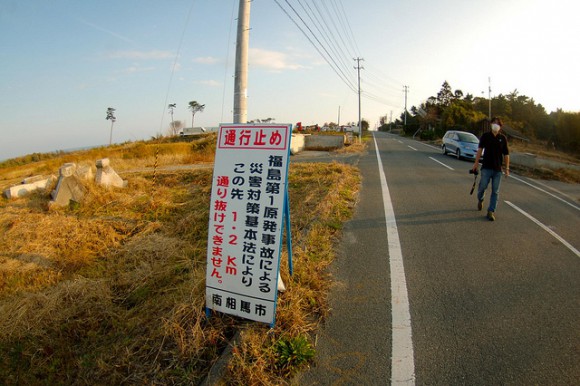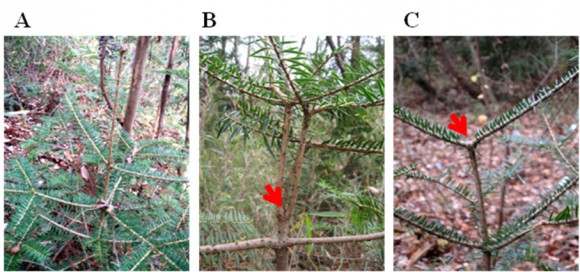
Following the events of the 2011 Tohoku earthquake and tsunami and the subsequent meltdowns at the Fukushima Daiichi Nuclear Power Plant complex, radiologists in Japan have been closely observing the area for potential changes. A new report by the National Institute of Radiological Sciences now suggests that the fir trees in Fukushima may be exhibiting strange growth patterns, with the radiation from the disaster being named as a possible factor.
The report, published on the organisation’s website on August 28, states that when comparing fir trees from within the affected zone to those from areas with lower radioactivity, the fir trees in the affected area were increasingly found to be stunted and exhibiting signs of morphological change, particularly bifurcation, the splitting of a body into two parts, i.e. ‘branching’.
Each year of a healthy fir tree’s growth sees it growing directly upward while also putting out two horizontal branches. Scientists have noted, however, that some of the trees in the affected areas are only branching off into two separate directions at the tip, and exhibiting lack of upward growth.
The changes can be identified in the below images, which were included with the report. Image A shows a normal example of growth. Note the vertical central branch. Photo B shows a trunk which has entirely split into two, and photo C shows horizontal growth only, with a distinct lack of vertical growth. The red arrows indicate where bifurcation has occurred. You can see in image C how the central, vertical branch of the tree which should be growing upward is missing entirely.
The investigation was conducted in January of this year, with trees examined in (S1) Okuma, Fukushima (3.5 kilometres from the nuclear plant), and two locations (S2, S3) in Namie, Fukushima (8.5 and 15 kilometres from the plant). Radiation levels in Okuma were recorded at 33.9 microsieverts, and in Namie, the levels were 19.6 and 6.85 microsieverts, respectively. These trees were compared against trees in the north of neighbouring Ibaraki Prefecture (S4) from an area with a microsievert reading of 0.13.
Between 100 and 200 trees in each location were examined for changes, with the effect seen more often in the areas with higher levels of radiation. 90% of the trees examined in Okuma exhibited some degree of morphological change, a number which fell to 40% and 30% in Namie, and to less than 10% in northern Ibaraki Prefecture.
The correlation between the frequency of the morphological change and the proximity to the Fukushima Daiichi site/level of radiation recorded suggests that it is likely—but as yet not confirmed—that the changes are connected to the increase in background radiation.
However, the report notes that this particular morphological change has been identified in other areas and can be attributed to a range of other factors including environmental changes and as a result of pest damage. The report states that rather than attributing this change directly to the nuclear disaster, researchers are instead presenting evidence that proves that this change is seen more often when radiation is a contributing factor.
Source: Report on Morphological Changes to Fir Trees in Areas with High Radiation, National Institute of Radiological Sciences via Asahi
Main Image: Flickr/raneko
Other Images: National Institute of Radiological Sciences



 Return to Fukushima: Decontaminated town reopens to residents, but is anybody living there?
Return to Fukushima: Decontaminated town reopens to residents, but is anybody living there? First worker to die from Fukushima radiation exposure officially recognized by Japan’s government
First worker to die from Fukushima radiation exposure officially recognized by Japan’s government New study shows wildlife thriving in areas evacuated after Fukushima nuclear meltdown【Video】
New study shows wildlife thriving in areas evacuated after Fukushima nuclear meltdown【Video】 New research suggests even low-level radiation in Fukushima negatively impacting wildlife
New research suggests even low-level radiation in Fukushima negatively impacting wildlife Google to Photograph Street Views of Evacuated Town in Fukushima
Google to Photograph Street Views of Evacuated Town in Fukushima Ramen restaurant’s English menu prices are nearly double its Japanese ones, denies discriminating
Ramen restaurant’s English menu prices are nearly double its Japanese ones, denies discriminating Top Japanese cosplayer Enako returns to Comiket after 6 years, creates mayhem with admirers
Top Japanese cosplayer Enako returns to Comiket after 6 years, creates mayhem with admirers Rakuten randomly offers 58 New Year’s osechi feasts in Japan, but did we get a star or a dud?
Rakuten randomly offers 58 New Year’s osechi feasts in Japan, but did we get a star or a dud? What makes a good boss in Japan? Workers sound off in survey
What makes a good boss in Japan? Workers sound off in survey Majority of Japanese mayors say foreign residents are essential but most see good and bad effects
Majority of Japanese mayors say foreign residents are essential but most see good and bad effects Here’s what our bachelor writers ate over the New Year’s holiday in Japan
Here’s what our bachelor writers ate over the New Year’s holiday in Japan Cosplay costume room tour by Japan’s number-one cosplayer Enako is an eye-opener【Video】
Cosplay costume room tour by Japan’s number-one cosplayer Enako is an eye-opener【Video】 That time Seiji called JASRAC to ask why he didn’t get paid royalties for his song being on TV
That time Seiji called JASRAC to ask why he didn’t get paid royalties for his song being on TV Visit the mythical cave that hid the Sun Goddess in Japanese mythology
Visit the mythical cave that hid the Sun Goddess in Japanese mythology The Purple Lucky Bag from Village Vanguard is an extra-large waste of money
The Purple Lucky Bag from Village Vanguard is an extra-large waste of money Japanese beef bowl chain Sukiya’s 2026 Smile Box lucky bag basically pays for itself
Japanese beef bowl chain Sukiya’s 2026 Smile Box lucky bag basically pays for itself Starbucks Japan ready to get Year of the Horse started with adorable drinkware and plushies【Pics】
Starbucks Japan ready to get Year of the Horse started with adorable drinkware and plushies【Pics】 Hayao Miyazaki says Happy New Year to Studio Ghibli fans with new art for Year of the Horse
Hayao Miyazaki says Happy New Year to Studio Ghibli fans with new art for Year of the Horse Cup Noodle tries an authentic Jiro-style ramen, but something’s not quite right
Cup Noodle tries an authentic Jiro-style ramen, but something’s not quite right The best Starbucks Japan Frappuccinos we want to drink again in 2026
The best Starbucks Japan Frappuccinos we want to drink again in 2026 We revisited Sweets Paradise after a decade to see if Japan’s dessert buffet still delivers
We revisited Sweets Paradise after a decade to see if Japan’s dessert buffet still delivers Pizza Hut Japan’s hot lucky bags are perfect for a New Year’s pizza party
Pizza Hut Japan’s hot lucky bags are perfect for a New Year’s pizza party 7-Eleven Japan starts new temporary luggage storage service in over 300 branches
7-Eleven Japan starts new temporary luggage storage service in over 300 branches Disillusionment at Tsukiji’s tourist-target prices led us to a great ramen restaurant in Tokyo
Disillusionment at Tsukiji’s tourist-target prices led us to a great ramen restaurant in Tokyo Starbucks teams up with 166-year-old Kyoto doll maker for Year of the Horse decorations【Photos】
Starbucks teams up with 166-year-old Kyoto doll maker for Year of the Horse decorations【Photos】 Tokyo considering law requiring more trash cans following litter increase in heavily touristed area
Tokyo considering law requiring more trash cans following litter increase in heavily touristed area Tokyo’s Tsukiji sushi neighborhood asks tour groups to stay away for the rest of the month
Tokyo’s Tsukiji sushi neighborhood asks tour groups to stay away for the rest of the month Tokyo event lets you travel back in time, for free, to celebrate 100 years since Showa era start
Tokyo event lets you travel back in time, for free, to celebrate 100 years since Showa era start Japan may add Japanese language proficiency, lifestyle classes to permanent foreign resident requirements
Japan may add Japanese language proficiency, lifestyle classes to permanent foreign resident requirements Sanrio theme park in Japan announces plans to expand into a Sanrio resort
Sanrio theme park in Japan announces plans to expand into a Sanrio resort Lacquerware supplier to emperor of Japan and Pokémon team up for new tableware
Lacquerware supplier to emperor of Japan and Pokémon team up for new tableware Survey asks foreign tourists what bothered them in Japan, more than half gave same answer
Survey asks foreign tourists what bothered them in Japan, more than half gave same answer Japan’s human washing machines will go on sale to general public, demos to be held in Tokyo
Japan’s human washing machines will go on sale to general public, demos to be held in Tokyo Japan’s deadliest food claims more victims, but why do people keep eating it for New Year’s?
Japan’s deadliest food claims more victims, but why do people keep eating it for New Year’s? We deeply regret going into this tunnel on our walk in the mountains of Japan
We deeply regret going into this tunnel on our walk in the mountains of Japan Studio Ghibli releases Kodama forest spirits from Princess Mononoke to light up your home
Studio Ghibli releases Kodama forest spirits from Princess Mononoke to light up your home Major Japanese hotel chain says reservations via overseas booking sites may not be valid
Major Japanese hotel chain says reservations via overseas booking sites may not be valid Put sesame oil in your coffee? Japanese maker says it’s the best way to start your day【Taste test】
Put sesame oil in your coffee? Japanese maker says it’s the best way to start your day【Taste test】 No more using real katana for tourism activities, Japan’s National Police Agency says
No more using real katana for tourism activities, Japan’s National Police Agency says Starbucks Japan reveals new sakura drinkware collection, inspired by evening cherry blossoms
Starbucks Japan reveals new sakura drinkware collection, inspired by evening cherry blossoms Updated cherry blossom forecast shows extra-long sakura season for Japan this year
Updated cherry blossom forecast shows extra-long sakura season for Japan this year Seven years after earthquake, Fukushima teen says March 11 is an “ordinary day” in the prefecture
Seven years after earthquake, Fukushima teen says March 11 is an “ordinary day” in the prefecture Japan government makes cute illustrated version of radioactive isotope it plans to dump into sea
Japan government makes cute illustrated version of radioactive isotope it plans to dump into sea
Leave a Reply